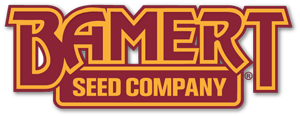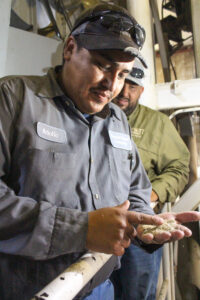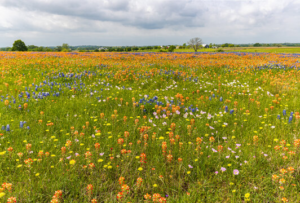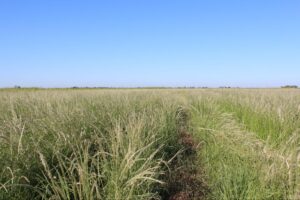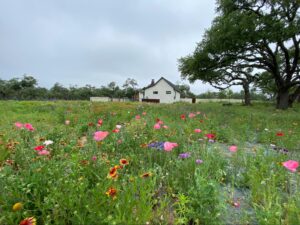
International Wildflower Week takes place June 17th through June 23rd. But, one week of recognition hardly seems like enough for such an impactful species of plant. Wildflowers are a pillar of any ecosystem, and essential for creating pollinator habitats.
Maybe you’re building a new housing complex and want to incorporate native flowers that improve your tenants’ living experience with water-wise flowers. Or maybe you’re working on a solar farm, and your seed spec emphasizes the need for pollinator-friendly wildflowers.
No matter your reason, here’s how to find the best wildflower seeds for creating a pollinator habitat in Texas.
What are the best wildflowers to plant in Texas?

We all know that the Lone Star State is a big state. The soil and climate varies greatly depending on where you’re located. To support native pollinators, you’ll want to select native plants based on your project’s location.
You’ll also want to consider what flowers act as a food source and what plants might be helpful to provide shelter for pollinators.
If you’re working on a big project, don’t take a gamble when selecting seeds.
The best way to ensure your wildflower establishment is to work with a Reclamation Specialist, who can take into account your soil, climate, and planting goals to maximize your investment. Our knowledgeable staff can assist you with creating the perfect blend for the pollinators in your area. Some of the industries we’ve worked with include construction, oil and gas, renewable energy, and agriculture.
We also sell premixed seed blends focused on pollinators. Some of our most popular blends, that take into account food and shelter for pollinators include:
- Texas Wildflower Blend
- Birds and Butterfly Mix
- Honey Bee Blend
- Texas Heritage Blend
- American Magic Wildflower Blend
- Wind Energy Wildflower Blend
- Solar Wildflower Blend
Consider planting a mix of many kinds of flowers to ensure you’re supporting a wide range of pollinators for a wide range of uses. Planting a variety of wildflower species that are adapted to your area will also help ensure you’ll have flowering plants throughout the entire growing season.
When should I plant wildflower seeds in Texas?
If you’re planting wildflower seeds in Texas, you should plan to plant them in the late summer or early fall, ideally around September or October. The only exception is some tropical southern regions in Texas, when it’s recommended to plant in November or December.
Perennial wildflower mixes usually include varieties and species with a cold stratification period. This means germination won’t take place until after a hard winter, which breaks their dormancy. While you may see some wildflowers pop up before it gets too cold, you likely won’t see your full range of blooms in a mix until the next spring.
You can sow wildflower seeds in Texas as late as January, although late summer or fall is preferred.
Best Practices to Increase Wildflower Stand and Germination
One perk of planting native wildflowers is that they already have a high tolerance for the region’s climate and the soil’s pH conditions. Planting is relatively straightforward and easy.
Soil Preparation
Soil preparation is often minimal when it comes to sowing wildflower seeds. They can be broadcast over undisturbed soil without any current vegetation. Like any plant, wildflower seeds need sun, water, and access to the soil to grow. Without all three, your seeds likely won’t germinate.
If you are planting into grass or forbs, mow down the existing plants as low as possible to give seeds ample space for the wildflower seeds to access the soil.
Some delays in germination can result from not preparing the soil.
Sowing the Seeds
Evenly distribute the seed to avoid overcrowding. Then, lightly rake or roll the area to increase seed to soil contact.
Watering
Native wildflowers seeds do not need irrigation and will grow with the water it receives from rain. That said, if you do have access to irrigation and can water flowers, this will help speed up germination and establishment.
Most of the projects we provide seed for at Bamert do not have irrigation.
Fertilizer
Before adding fertilizer, make sure to do a soil test. We recommend using fertilizer if your soil lacks nutrients.
What happens if you just scatter wildflower seeds?
Scattering wildflower seeds in a particular area is fine, as long as they can come into contact with the ground. Seed to soil contact is essential for germination and establishment.
Be sure to mow down any existing plants as low as possible when seeding. Then, roll or drag the area to ensure seeds have made contact with the soil.
What happens if you plant too many wildflower seeds?
If you plant too many wildflower seeds, it can result in crowding and reduced flowering. Ultimately, overplanting defeats the whole point of planting wildflowers if you’re trying to create a pollinator habitat!
How long does it take for wildflower seeds to start growing?
Each seed is unique, and we recommend speaking to an expert about when the wildflowers in your blend will germinate. But, most seeds germinate 10 to 20 days after planting.
Depending on when you plant, some seeds may not germinate until the following spring.
What pollinators need Texas wildflowers?

There are many pollinators that depend on wildflowers in one way or another. Some of these include:
- Ants
- Bats
- Bees
- Beetles
- Butterflies
- Flies
- Moths
- Wasps
- Hummingbirds
Wildflowers give these pollinators the opportunity to support the surrounding ecosystem, including plants that produce berries, nuts, pods, and other fruit. These other food sources are pivotal for a diverse population of birds, insects, reptiles, and mammals.
Planting wildflowers and creating pollinator habitats is a great way to support the greater ecosystem of any given area.
A Special Focus on Native Bees
Native Texas wildflowers in particular can make an especially big impact. There are roughly 700 native bee species in Texas. Each species is especially equipped to collect and distribute pollen via pollen carrying structures on their body. Some of these bees include the Texas Bumblebee, Carpenter Bee, and American Long-Horned Bee.
Bees need pollen to support the health and growth of their larvae, which means they collect and move more pollen than many other pollinators. As they fly from flower to flower, they rub off or drop pollen along the way. A bee may visit several hundred flowers in a day.
When deciding which flowers to stop at, they usually prefer native flowers in bloom, making them more efficient at supporting native plants.
Best Practices for Picking Texas Wildflower Seeds
When selecting Texas wildflower seeds, choose a mix that offers a range of blooming periods. This can provide continuous nourishment from March to November. Plants that support pollinators during months where little food is present are especially integral to their survival.
Look for a seed supplier with their own production fields and state-of-the-art seed cleaning facilities so you eliminate any middlemen. That way, you’ll get the highest quality seed at the best pricing.
Your seed supplier should also have a wide selection of seeds to choose from. At Bamert, we have 400 species of high-quality native grasses, forbs, and legumes.
Someone with a proven track record in your industry can also be invaluable. We’ve worked on reclamation projects, prairie restorations, DOT projects, conservation programs, and wildlife habitats. Our Reclamation Specialists are always available to make sure you select the right seeds for your project and get them to you quickly.
Ready to purchase your wildflower seeds? Fill out a contact form to connect with a specialist who can help you make the right seed selection for your project.
